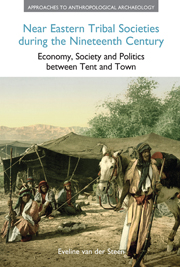 Near Eastern Tribal Societies during the Nineteenth Century
Near Eastern Tribal Societies during the Nineteenth Century Book contents
- Frontmatter
- Dedication
- Contents
- Acknowledgements
- Introduction
- 1 What is a tribe?
- 2 Travellers in the Levant during the nineteenth century
- 3 The dynamics of territorial and power structures
- 4 Oral traditions
- 5 Tribal society and its relation to the landscape
- 6 Tribal institutions
- 7 Relations between the tribes and the state
- 8 From tribe to tribal state: three case studies
- 9 The economy of tribal societies
- 10 Ethnicity and the sense of belonging
- 11 Women in tribal societies
- 12 Religion and folklore
- 13 Back in time: historical parallels
- Notes
- References
- Index
2 - Travellers in the Levant during the nineteenth century
- Frontmatter
- Dedication
- Contents
- Acknowledgements
- Introduction
- 1 What is a tribe?
- 2 Travellers in the Levant during the nineteenth century
- 3 The dynamics of territorial and power structures
- 4 Oral traditions
- 5 Tribal society and its relation to the landscape
- 6 Tribal institutions
- 7 Relations between the tribes and the state
- 8 From tribe to tribal state: three case studies
- 9 The economy of tribal societies
- 10 Ethnicity and the sense of belonging
- 11 Women in tribal societies
- 12 Religion and folklore
- 13 Back in time: historical parallels
- Notes
- References
- Index
Summary
Frank had taken his degree, as arranged, and had then gone abroad for the winter, doing the fashionable things, going up the Nile, crossing over to Mount Sinai, thence over the long desert to Jerusalem, and home by Damascus, Beyrout, and Constantinople, bringing back a long beard, a red cap, and a chibouk …
(Anthony Trollope, Dr. Thorne, 1858)Introduction
During the nineteenth century, first a trickle, then a stream and then an avalanche of travel books about the Near East appeared all over the Western world but particularly in Britain. Most of these covered one small part of the region: Palestine – the Holy Land. As a result of this, over the course of the century Palestine became one of the fashionable holiday destinations for the wealthy, a phenomenon that generated even more travelogues. According to Bar-Yosef (2005: 68): “The number of individuals who were willing to risk their own assets just to have their travel accounts published … suggests that it was only by joining this endless textual procession that travellers felt they had truly experienced Palestine.”
Travellers quoted, copied and plagiarized each other. Armchair scholars used these travelogues to draw up a picture of life as it must have been in the days of the Patriarchs and to “follow in the footsteps of Jesus” without ever having set foot in the Holy Land. Painters and illustrators depended on on-site sketches from travellers to paint their panoramas of the Holy Land and their impressions of daily life in the East.
- Type
- Chapter
- Information
- Near Eastern Tribal Societies during the Nineteenth CenturyEconomy, Society and Politics between Tent and Town, pp. 18 - 37Publisher: Acumen PublishingPrint publication year: 2013


